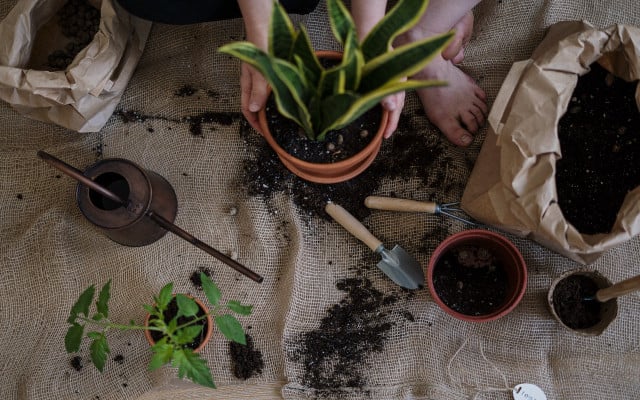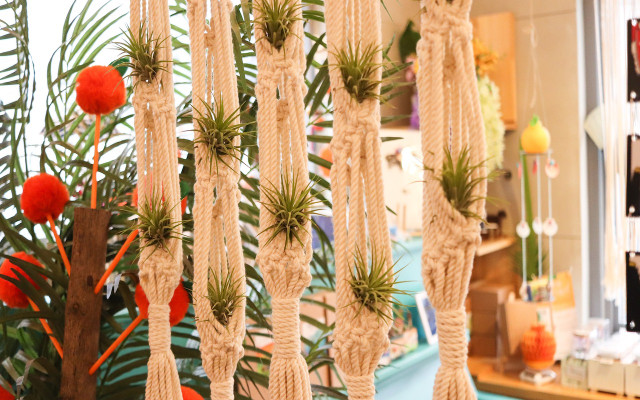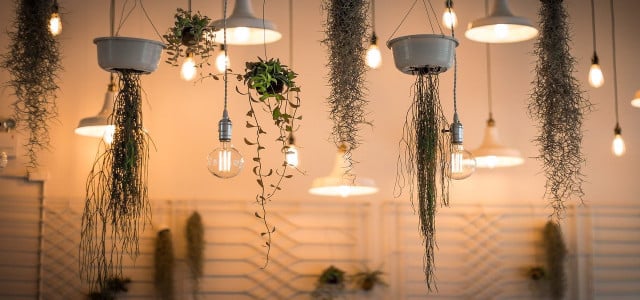Indoor hanging plants can give a very ethereal feel to any room, which may be why we love them so much! They are visually appealing and can have some surprising health benefits. We’ve compiled a list of our favorite varieties and some tips on how to care for them.
Taking Care of Your Indoor Hanging Plants
Like any potted plant, even the best indoor hanging plants do need some care and maintenance – some varieties tend to be a bit more sensitive than others. Don’t have a green thumb? Read more here: Keep Your Houseplants Alive: 10 Tips for Healthy Indoor Plants
Watering: When it comes to indoor plants, it is easy to over or under water. To avoid root rot and waterlogging, try watering more often, using less water. Consider filling the bottoms of your pots with stones for extra drainage.
Pruning: There are many reasons why you may want to trim back your hanging plant. Maybe it’s getting too long, or you want it to fill in a bit more. To encourage the best growth, pruning should occur at the beginning of the growing season, typically late winter or early spring.
Transplanting: No matter which indoor hanging plant you decide to put in your house, there will come a time when it will need to be repotted. Carefully transplant it into a bigger pot and continue to care for it as normal.

Low Maintenance Indoor Hanging Plants
Spider Plant (Chlorophytum comosum)
These spindly plants are characterized by their stunning long and thin green and white leaves. They are easy to grow, both tall and wide, and can fill up any large space.
- Keep them in very bright, indirect sunlight for best results
- Water when the soil starts to get dry and repot once a year
- Air purifying, but toxic to pets
Pothos (Epipremnum aureum)
Known as one of the absolute best indoor hanging plants for beginners because it requires very little care, but produces gorgeous greenery. Choose from varieties such as Golden, Marble Queen, Neon, or Pearls & Jade.
- Prefers moderate light, but can adapt to low light areas
- Let it dry out between waterings
- Air purifying, but toxic to pets



Air Plants (Tillandsia)
Air plants are the perfect no-maintenance plant you can hang just about anywhere as they don’t require soil of any sort. They are among the best indoor hanging plants because they are fun to play around with as the ways to display them are endless.
- Prefers a space with bright light and plenty of air circulation
- Give them a slight misting every once in a while
- Tip: Try hanging them in glass terrariums**
Heartleaf Philodendron (Philodendron scandens)
Often confused with Pothos plants, these plants have dark, glossy, heart-shaped leaves that trail beautifully. Once you know your stuff, you will never get them confused!
- Requires Moderate light
- Allow to dry out between waterings (extremely forgiving if you forget to water them)
- Air purifying, but toxic to pets
Best Indoor Hanging Plants for Colour
Christmas Cactus (Schlumbergera)
Due to the way the flowers cascade down, it makes an ideal indoor hanging plant. There are several different varieties with differing blooming times and colors.
- Allow to dry out fully between waterings
- Place in a very bright space
- Fertilize once a month during growing season for best results
Chenille Plant (Acalypha hispida)
When grown in an ideal environment, these plants can grow up to 6ft long! They require regular pruning so are a bit more high maintenance. Red, caterpillar-like flowers add a fun pop of colour to any space.
- Prefers very bright and sunshine filled areas
- Keep moderately moist for best results
- Best kept in a low-traffic area due to the cascading flowers



Hanging Tips
Hanging plants are a great way to add greenery while maximizing space. There are a few things to keep in mind when it comes to hanging indoor plants.
For plants that grow quite long, consider hanging them higher to really show off their length. You can also trick your plant into growing the way you want. Using tall, skinny pots forces the greenery to shoot up and cascade down, while wider pots allows them to spread a bit more.
The type of pot also makes a difference when it comes to indoor hanging plants. Clay pots dry out fast and are ideal for plants that are sensitive to overwatering. Ceramic pots are great for retaining moisture and creating a more humid environment.
Houseplant Benefits
Having plants indoors adds a beautiful pop of colour and some texture to a room, but there are plenty of other reasons to add some to your space. Not only are they said to improve air quality, plants also play a role in reducing stress and lifting moods. Even if you don’t have a green thumb, there’s a houseplant out there for everyone!
** Links to retailers marked with ** or underlined orange are partially partner links: If you buy here, you actively support Utopia.org, because we will receive a small part of the sales proceeds. More info.Do you like this post?






